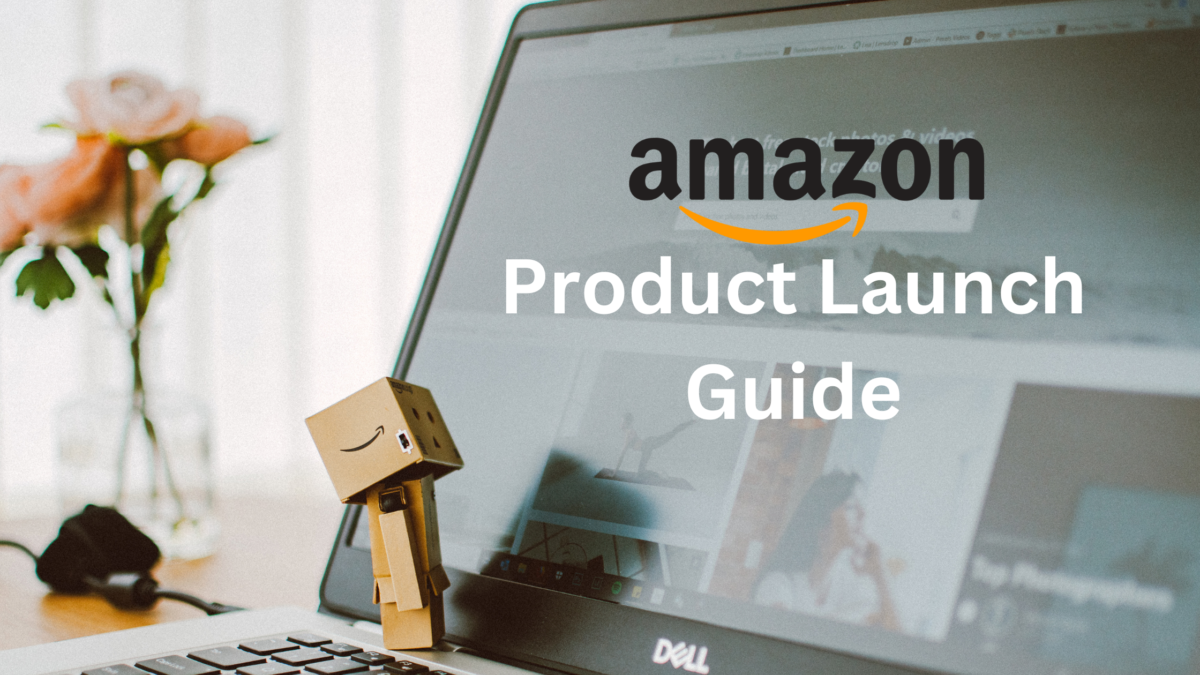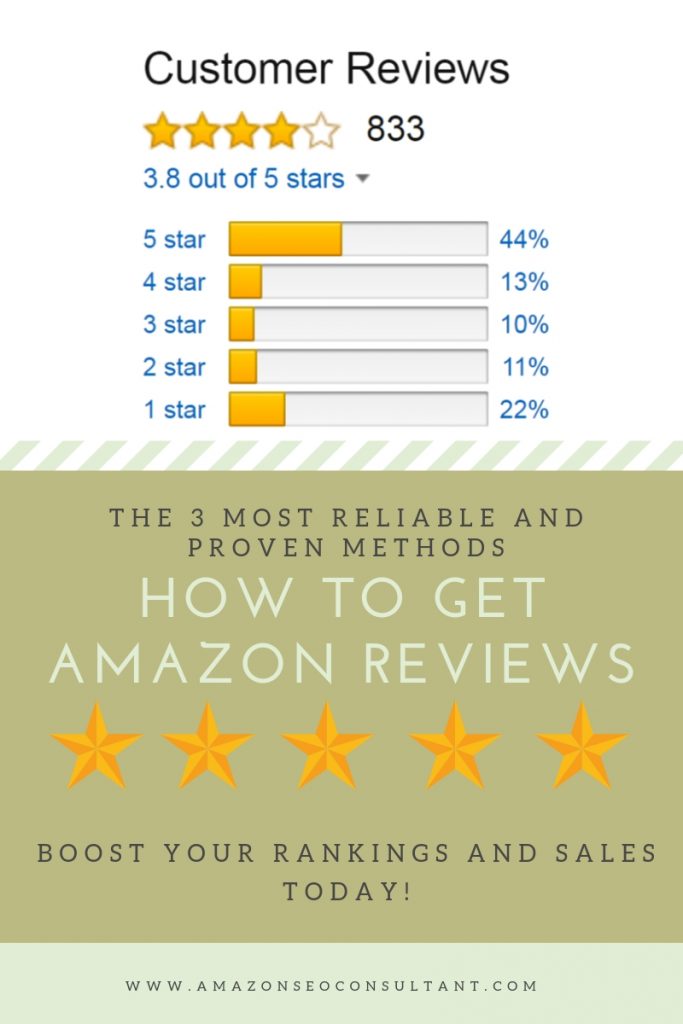
Reviews can be one of the biggest catch-22s for Amazon sellers.
Without enough positive reviews, no matter how well optimised your listings may be, they are going to struggle, both to convert potential customers into buyers and to move up the rankings and stick.
As a result, getting reviews on Amazon, (ideally positive reviews, of course), is one of the most important ranking factors outside of keyword focused sales.
If you and a competitor are selling a very similar product at a very similar price, but the competitor’s listing has 2,000 reviews with an average rating of 4.5 stars, and your listing only has 20 reviews, which one do you think the vast majority of customers will go for?
More importantly, which one would you be more inclined to trust yourself?
The bottom line is, how to get more Amazon reviews in 2019 should be a priority for anybody selling via the platform.
You don’t necessarily need to have more than everybody else, but reviews have a direct and major impact on your listings click-through rate and conversion rate – so the more the better.
So, without further ado, let’s take a look at some of our proven tips on how to get reviews on Amazon in 2019:
First Things First – Have a Review Worthy Product

This should be painfully obvious, but it apparently needs to be said regardless.
If your products have a major feature missing, don’t do what your customers expect them to do do, or aren’t satisfying customers as much as your competitors’ products are, trying to build up your positive reviews will be like swimming against the current, if not straight up impossible.
If your product is really good however, then in the same way, positive reviews will naturally come on a regular basis.
As a result, the best first move may be to analyse the reviews you are receiving, especially the negative ones, to learn what people don’t like about your product and how you can improve it.
You can do the same thing with similar products by checking out your competitor’s reviews to learn which features are a hit with buyers and therefore might be worth adding to your own offering, and which features are complained about often and therefore are probably best avoided.

Put it this way – if you sell a Bluetooth speaker that has terrible battery life but is otherwise a perfectly decent device, chances are you’ll see a lot of reviews complaining about the battery.
Now, you could just ignore them and keep selling the product as is – but those negative reviews won’t go anywhere, leading to a reduction in your average star rating and your ranking over time, as well as giving your products a reputation for bad battery life, something that will equally reduce sales.
Now, going back to the drawing board and fixing that product with an increase in battery size or decreased power draw may well be costly and annoying at the time, but it will also lead to improved reviews over time, which leads directly into increasing rankings, increased orders, and therefore even more positive reviews.
It’s crucial you focus on this part first as if you have a bad product, all of the world’s tips on how to get Amazon reviews won’t help you.
With that in mind, let’s take a look at the first of our tips:
1: Include a Surprise Freebie or Sell Products as Bundles
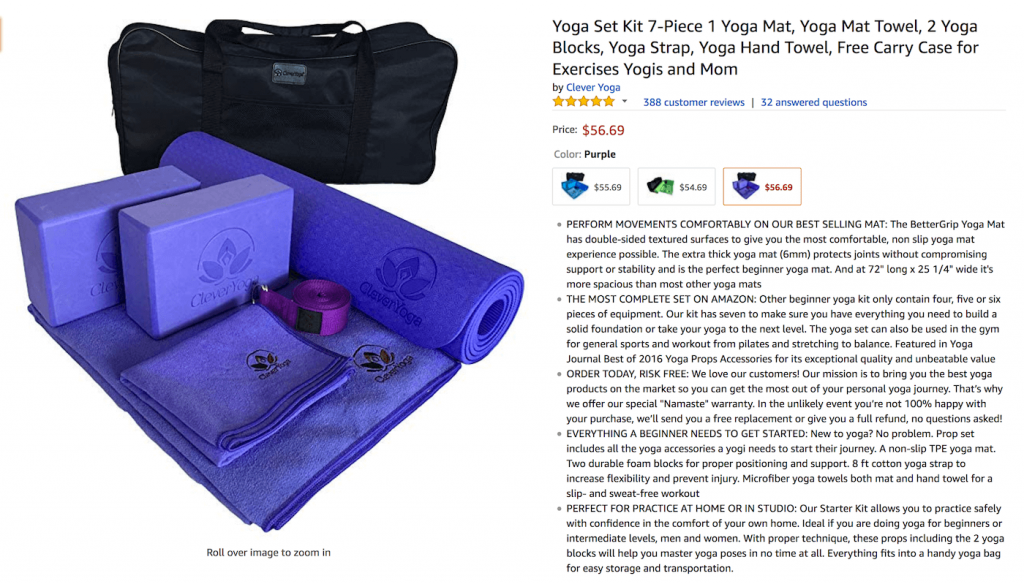
Ok so, if you’ve already followed the above and made sure you have a high-quality product at a great price point, then most of your reviews should be on the positive side of things anyway.
In this case, what you need is some unexpected value to encourage reviews from customers who otherwise wouldn’t really bother, and to win over the tough to impress crowd who still may not be 100% happy.
A surprise freebie is an incredible way to do this and increases both the perceived value of your product and the satisfaction of the customer.
These freebies can be digital content, for example, free eBooks, downloadable tutorial videos, etc, or they can be actual physical items such as including a free recipe book with a slow cooker.
This sort of content can be outsourced and is usually pretty cheap to create, but it does increase the perceived value of your product substantially, especially when received unexpectedly.
Of course, you can actually achieve the same thing up front, by bundling multiple related products together into a themed pack to sell on Amazon.
While this removes the element of surprise, it does create a highly useful offering that will often be more tempting than the sum of its parts.
2: Include Product Inserts

Product inserts are printed information included inside the packaging of an online order and are an extremely popular and proven way to increase the likelihood of receiving a review.
Chances are you already include some form of product insert, offering your customers your contact details, social media handles, vouchers off their next purchase, and similar.
If this isn’t the case, you should really consider it, as all of these things can work together to increase brand engagement and repeat orders.
It goes without saying that these inserts should be as concise, clear and well-designed as possible, otherwise most people won’t read them.
Adding a voucher or discount code certainly attracts the eye, however, and so does framing the product insert as a friendly thank you note to each buyer.
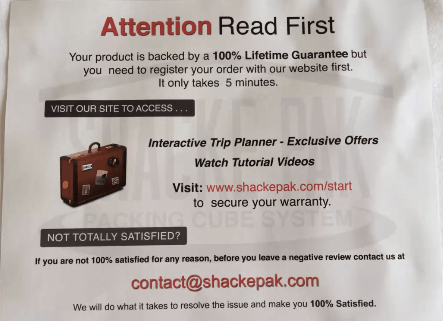
It’s important here to suggest that your customer contacts you instead of leaving a review if they have an issue with their purchase, giving you the chance to fix their issue and create a positive experience between the customer and your brand.
However, try not to be too obvious that that’s what you’re doing, and simply word it along these lines:
Thanks a lot for your order!
We hope you are enjoying your purchase.
If there is an issue such as damage or you aren’t 100% happy with your item, please contact us immediately so we can correct any problems for you.
Otherwise, we would appreciate it if you could leave us a review – as a fairly new company trying to make it on Amazon, they are more helpful than you’d realise!
Either way, we hope you have a great day and don’t forget to get in touch if you have any issues or questions!
This achieves a lot in such a small amount of text – if your customer is happy with their order and it is all finished as far as they are concerned, they are now considering leaving a review, even if it didn’t cross their mind before.
If they are unhappy, they have now been redirected to contacting you and giving you a chance to fix the issue instead of simply leaving a negative review.
It’s important you work on your customer services experience and try to resolve as many of these issues as you can, leading to more happy customers and therefore more positive reviews.
Remember, it’s against Amazon’s terms of service to ask a buyer for a positive review specifically, but giving them the option to resolve any negative issues beforehand essentially does the same thing without directly saying it.
For those who are wondering how to increase Amazon reviews without a huge cost or increase in effort, this is it – for the cost of getting a professional quality insert printed and printing more of them every now and then, you can get a marked and measurable increase in your reviews, and redirect some of the people who would have left negative reviews to your customer service email address instead.
3: Set Up an Automated Email Followup

Email follow-up campaigns work in a similar way to product inserts – giving a note reminding and encouraging your customers to leave a review.
The way in which emails are different is they can be set to send a specific amount of time after an order is delivered (2 hours, 2 days, 2 weeks, whatever works for you).
This often works well in addition to a product insert as opposed to instead of one, as a customer may well see your insert and intend to leave a review, but then forget, and be reminded again by the email.
The email should also remind those who never read the insert, or who were unhappy at the time of delivery but have now had their issues resolved, making it arguably the most effective method listed here.
Of course, it’s important not to spam your customers as this can annoy them, so keep your automated emails reasonable and tied to important stages of the order process.

You should also be creative with your subject lines, going for a personal touch to increase the likelihood of them opening the email in the first place.
For example, the subject line “Hi Harriet, a few notes regarding your Amazon order” seems a lot more genuine and appealing to open than something formal and overly technical like “Order #23945 Invoice” – which suggests to the reader that it’s either a fake spam email or a breakdown of the order details that they are already aware of – who would care to open that?
Here are a few automated emails to consider setting up:
Order Confirmed
This should be sent immediately after the customer confirms and pays for their order.
The main aim of this email should be to thank the customer for their order, introduce your company in a friendly and human manner, give them a reasonable and realistic expectation on when they will receive the item, and give a link to contact you, inviting them to do so if they experience any problems.
This starts the whole relationship off on the right foot, let’s them know what to expect and encourages them to chase up their order with you if delivery is late, instead of just leaving a negative review.
Order Follow Up
This email should be sent a day or two after the order is delivered.
In this email, you should simply state that they should have their order by now, that you hope they enjoy it thoroughly and that they should contact you if they have any issues.
This will head off any shipping issues by reminding them to contact you immediately if the package is late, and give off the general feeling that you care about the whole process and are ready to help them.
Often, you will find customers respond to this email with a positive review even though you haven’t mentioned it since they likely have their product already and you have made it clear how much you care about their experience.
Review Request
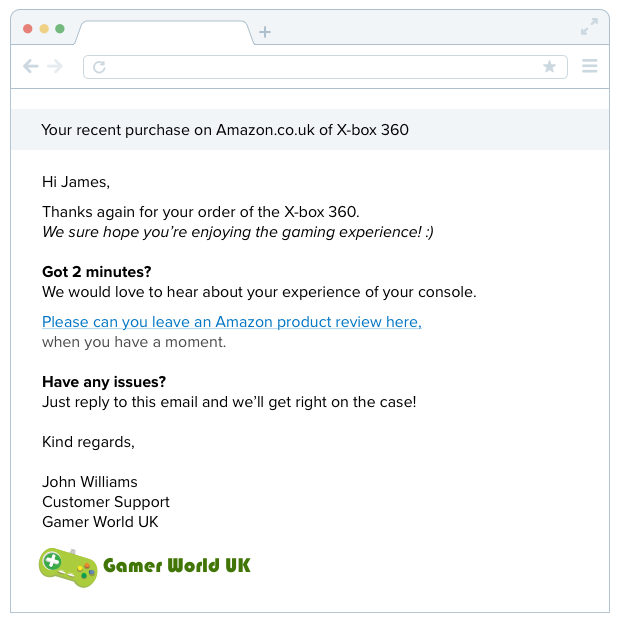
Between 5 and 14 days after delivery, when your customer has had the chance to use the product, your final email should be sent.
You basically want to start by saying “we hope you are enjoying your product” and you can even remind them of any freebies you threw in by adding “I hope you got some great ideas on how to use your juicer from the free recipe book we added for you!”.
You can then throw in the same subtle request to contact you if they have any issues or to leave a review if they’re happy, just like you did on the product insert.
You may have more email ideas that could work, so don’t be afraid to come up with your own ideas and look elsewhere – but these are the reliable, proven methods that are guaranteed to increase the number of positive reviews you receive, so be sure to implement them first and then you can do your own research.
Final Notes
That’s it for our three tips – implementing them into your Amazon strategy is guaranteed to increase your reviews, and therefore orders.
However, we wanted to mention a couple more things here for the sake of being comprehensive:
Incentivised Reviews
Incentivised reviews used to be a major strategy in Amazon, with many sellers offering discounted or even free products in return for a positive review.
This worked wonders at the time, with many sellers able to build up thousands of positive reviews through this method.
Fortunately, (or unfortunately depending on how you look at it), Amazon has now cut down on this hugely and trying it is likely to get your account banned.
With that said, it can still be done on a much smaller scale, for example through your friends and family, while remaining essentially impossible to track.
We have a post on this entitled Why Amazon Can’t Really Track Fake Reviews, so check it out if you’re interested, but remember this is against Amazon’s rules and done entirely at your own risk.
Amazon review services are also available to purchase, although we wouldn’t recommend this as they are often spam reviews sent repeatedly from the same person in bad English.
We do help our Partners build up their positive reviews, but tend to do this through “natural” and “real” methods like the ones listed above.
Keyword Focused Sales
Keyword focused sales are one of the most reliable methods to boost your product’s Amazon ranking.
It essentially consists of real, ordinary people searching a specific search term and buying your product.
This increases your products rank for that search term, leading to more sales and more reviews.
You can purchase the most reliable and legitimate keyword focused sales from us, so check out our order page to learn more.
If you’d rather us help directly and push your Amazon business to the next level, consider filling in our proposal form to see how our proven ranking process could help you!
We hope you have enjoyed this guide on how to get reviews for Amazon products – we will bring more regular in-depth guides on a regular basis, and in the meantime, we recommend checking out our full Guide to Selling on Amazon for more data-driven and proven tips.
